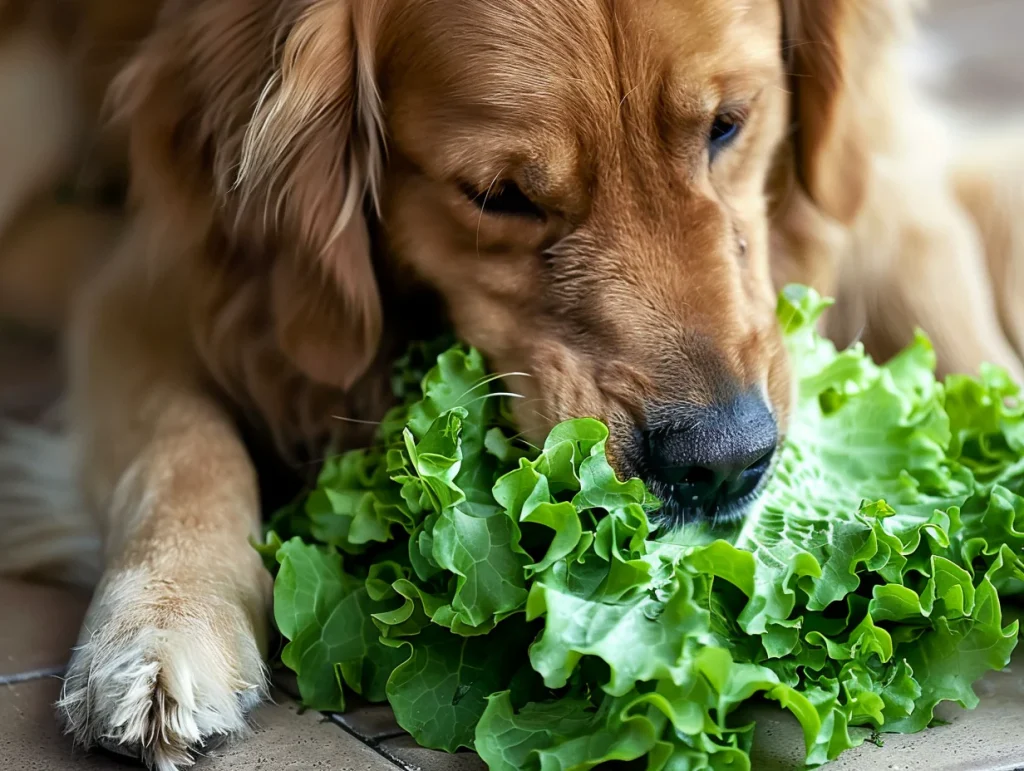Picture this: you’re tossing together a salad, and your dog is sitting right at your feet, head tilted, ears perked, eyes following every leaf you tear.
You start wondering, “Can I give them some of this?” Dogs and human foods are tricky territory, and lettuce often gets second-guessed.

While it’s not harmful in moderation, it’s worth knowing the ins and outs before letting your pup munch.
Is Lettuce Safe For Dogs
Plain lettuce is generally safe for dogs. It’s low in calories, hydrating, and adds a bit of crunch to their diet. But “safe” doesn’t mean unlimited.
Overfeeding can lead to digestive upset. Some types of lettuce are better than others, so it’s smart to know which ones work best for your furry friend.
If your dog is watching your salad with puppy eyes, a little leaf won’t hurt. Just don’t hand over the whole bowl.
Nutritional Benefits Of Lettuce
While lettuce isn’t exactly a superfood, it has some perks. It contains fiber, which aids digestion, and some vitamins like A, K, and C in small amounts.
Plus, the water content can help keep dogs hydrated, especially on hot days. For pups who love crunch, it’s a low-calorie snack that adds variety without making them gain weight.
For senior dogs or those on a weight-loss plan, lettuce is a crunchy treat that won’t mess with their diet. And unlike some snacks, it won’t leave your dog begging for more sugar or carbs.
Types Of Lettuce That Are Better
Not all lettuce is created equal. Iceberg is mostly water with minimal nutrients. Romaine is better—it has more fiber and vitamins. Other leafy greens like butterhead or green leaf are safe, but avoid anything with seasoning or dressing.
If your dog is a picky eater, romaine might be the one that wins them over. Iceberg is fine for crunch, but nutritionally, it doesn’t add much.
How To Prepare Lettuce For Dogs
Wash leaves thoroughly to remove dirt, pesticides, and bacteria. Chop into small pieces to avoid choking hazards, especially for tiny breeds. Keep it plain, no salt, oil, or salad dressing.
You can even mix lettuce into their kibble or use it as a topper to make meals more interesting. Just make sure the lettuce is clean, fresh, and free from any additives.
Recommended Serving Sizes And Frequency
A few small pieces per day or a couple of leaves a few times a week is plenty. For larger dogs, you can offer a bit more, but don’t go overboard. Think of lettuce as a bonus snack, not a meal replacement.
Treats in moderation are key. Overfeeding veggies, even safe ones, can cause gas or soft stools.
Possible Digestive Issues
Too much lettuce at once can cause bloating, diarrhea, or gas. Dogs have sensitive stomachs, and sudden dietary changes can upset their digestive system. Introduce lettuce slowly and watch how they respond.
Dogs with sensitive stomachs or pre-existing digestive conditions may need smaller portions or a different veggie option entirely.
Comparing Lettuce With Other Vegetables
Dogs can enjoy a range of safe veggies like carrots, cucumbers, green beans, or bell peppers.
Lettuce is low-calorie and hydrating, but it doesn’t have as many vitamins or minerals as some other vegetables. Mixing in different safe options gives more variety and nutrition.
For picky eaters, starting with lettuce can be an easy gateway to introducing other vegetables. Carrots or green beans can follow once they enjoy the crunch.
Signs Your Dog Might Not Tolerate Lettuce
If your dog vomits, has loose stools, or seems uncomfortable after eating lettuce, it may not agree with them. Sensitivities vary by dog, so keep an eye out for negative reactions and adjust accordingly.
Allergies to lettuce are rare, but some dogs just have sensitive stomachs. Pay attention to subtle signs like excessive drooling, pawing at the mouth, or reluctance to eat.
Role Of Lettuce In Weight Management And Hydration
For overweight dogs, lettuce is a low-calorie snack that helps satisfy crunch cravings. Its high water content also supports hydration, which is important during summer walks or after play sessions.
Using lettuce as a filler treat can help dogs feel full without adding a lot of calories. It’s a win-win for weight management and snack variety.
Introducing Lettuce Gradually
Start with one or two small pieces and see how your dog reacts. Gradually increase portions if tolerated well. Using lettuce as a training treat can be fun, low-calorie, and easy on their digestive system.
Try mixing lettuce with other dog-safe vegetables to keep it interesting. Some dogs love the texture, while others might need encouragement to munch on greens.
Fun Ways To Serve Lettuce
You can freeze chopped lettuce as a crunchy summer snack. Some dogs love the cold crunch, and it can soothe teething puppies. Tossing a little lettuce into their food for extra texture also works.
Keep it creative, but always plain and washed. The frozen crunch trick is particularly good for playful chewers who like to nibble.
Special Considerations
Senior dogs or dogs with digestive sensitivities should start with smaller portions. Watch for constipation or diarrhea and adjust their intake. Some dogs may enjoy lettuce for hydration if they aren’t drinking enough water, but it’s not a substitute for fresh water.
Always supervise your dog when trying new foods, especially leafy greens that could get stuck in the throat if not chopped properly.
Conclusion
So yes, you can give your dog lettuce, but keep it clean, plain, and in moderation. Introduce it gradually, watch for reactions, and mix with other safe veggies for variety. Crunchy, hydrating, and low-calorie, lettuce is a friendly snack for most pups.
When your dog watches you chop the salad next, which leaf will you offer first, and will it become their new favorite snack?